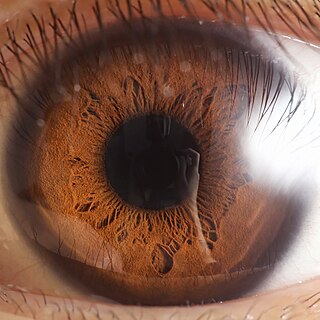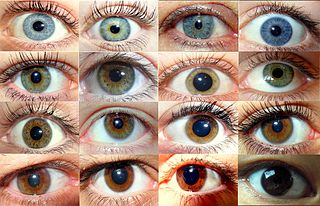Related Research Articles

In botany, a bulb is structurally a short stem with fleshy leaves or leaf bases that function as food storage organs during dormancy.

Dame Jean Iris Murdoch was an Irish and British novelist and philosopher. Murdoch is best known for her novels about good and evil, sexual relationships, morality, and the power of the unconscious. Her first published novel, Under the Net (1954), was selected in 1998 as one of Modern Library's 100 best English-language novels of the 20th century. Her 1978 novel The Sea, The Sea won the Booker Prize. In 1987, she was made a Dame by Queen Elizabeth II for services to literature. In 2008, The Times ranked Murdoch twelfth on a list of "The 50 greatest British writers since 1945".

Iris is a flowering plant genus of 310 accepted species with showy flowers. As well as being the scientific name, iris is also widely used as a common name for all Iris species, as well as some belonging to other closely related genera. A common name for some species is flags, while the plants of the subgenus Scorpiris are widely known as junos, particularly in horticulture. It is a popular garden flower.

In humans and most mammals and birds, the iris is a thin, annular structure in the eye, responsible for controlling the diameter and size of the pupil, and thus the amount of light reaching the retina. Eye color is defined by the iris. In optical terms, the pupil is the eye's aperture, while the iris is the diaphragm.

The Germs is a comic strip in the UK comic The Beano. It first appeared in issue 2374, dated 16 January 1988, replacing the Rasher strip, where the characters had been introduced the previous week.

Heterochromia is a variation in coloration most often used to describe color differences of the iris, but can also be applied to color variation of hair or skin. Heterochromia is determined by the production, delivery, and concentration of melanin. It may be inherited, or caused by genetic mosaicism, chimerism, disease, or injury. It occurs in humans and certain breeds of domesticated animals.

Ocular synechia is an eye condition where the iris adheres to either the cornea or lens. Synechiae can be caused by ocular trauma, iritis or iridocyclitis and may lead to certain types of glaucoma. It is sometimes visible on careful examination but usually more easily through an ophthalmoscope or slit-lamp.

Eye color is a polygenic phenotypic trait determined by two factors: the pigmentation of the eye's iris and the frequency-dependence of the scattering of light by the turbid medium in the stroma of the iris.

Orris oil is an essential oil derived from irises, particularly Iris germanica. It is sometimes used as a flavoring agent and as an ingredient in perfume production. It can also have uses in body lotions.

Neusticosaurus, is an extinct genus of marine reptile belonging to the pachypleurosaurs, from Italy, Switzerland and Germany. Neusticosaurus was one of the smallest nothosaurs and probably fed on small fish.

Iris pallida, the Dalmatian iris or sweet iris, is a hardy flowering perennial plant of the genus Iris, family Iridaceae. It is native to the Dalmatian coast (Croatia) but widely naturalised elsewhere. It is a member of the subgenus Iris, meaning that it is a bearded iris, and grows from a rhizome.

Cloud iridescence or irisation is a colorful optical phenomenon that occurs in a cloud and appears in the general proximity of the Sun or Moon. The colors resemble those seen in soap bubbles and oil on a water surface. It is a type of photometeor. This fairly common phenomenon is most often observed in altocumulus, cirrocumulus, lenticular, and cirrus clouds. They sometimes appear as bands parallel to the edge of the clouds. Iridescence is also seen in the much rarer polar stratospheric clouds, also called nacreous clouds.

Iridoideae is one of the two main subfamilies in the popular family Iridaceae. It contains the best-known genus - Iris. The members of this subfamily are widely distributed worldwide. They grow in all continents except Antarctica.
An iris shot is a technique used in silent film and television sometimes to emphasize a detail of a scene above all others, more commonly to end or open a scene. The film camera's iris is slowly closed or opened, so that what is visible on film appears in a decreasing or increasing circle, surrounded by black.

The Yasme Foundation is a non-profit corporation organized to conduct scientific and educational projects related to amateur radio, including DXing and the introduction and promotion of amateur radio in underdeveloped countries. It is located in Castro Valley, California.
Iris scissors are a type of scissors with short blades that was originally developed for ophthalmic surgery. They are alternatively referred to as Iris forceps in the United Kingdom and Asia. Iris scissors are also available in the crafting market and are sometimes used for the production of fabric-related goods. Both closed and open shank versions are available.

Iris nigricans is a flowering plant in the family Iridaceae. It is the national flower of Jordan. The flowers are blackish-purple and 12–15 centimetres (4.7–5.9 in) in diameter, and the plants are 35 cm (14 in) tall with recurved leaves. It needs direct sun and sharp drainage. It is endemic to Jordan and is an endangered species.

Plateau iris is a medical condition of the eye resulting from anterior displacement of the peripheral iris by the ciliary body, causing angle closure glaucoma. First line treatment for all causes of narrow angle glaucoma is laser iridotomy. If narrow angle glaucoma persists after iridotomy, it is called plateau iris syndrome and subsequently managed either medically (miotics) or surgically. This condition is sometimes discovered after an iridotomy causes a rapid increase in eye pressure. Due to its rarity, few ophthalmologists have experience with treating those affected by plateau iris syndrome.

Iris subbiflora is a plant species in the genus Iris, it is also in the subgenus Iris. It is a rhizomatous perennial, from Portugal and Spain in Europe. It has evergreen broad leaves, forming dense clumps, it has dwarf stems in late spring,, with 1 upright fragrant flower, in shades of purple, light red purple, grey-blue, blue-violet, or dark violet. It has a beard which is generally blue, purple, or violet, but can fade to white, dull yellow, or dark yellow. After being found in 1804, it was once a separate species until the late 70s, when it was reclassified as subspecies of Iris lutescens, and renamed Iris lutescens subsp. subbiflora. But in the 80s it was returned to an independent species but some authors and references still class the species as a synonym or subspecies. It is cultivated as an ornamental plant in temperate regions.

Iris Takes the Fallen Hero to Olympus, or sometimes Nike Takes the Fallen Hero to Olympus is an 1857 sculpture by August Wredow, installed on Schlossbrücke in Berlin, Germany.
References
- ↑ Voronina, E. P. (2010-11-01). "On morphology and taxonomy of scophthalmids". Journal of Ichthyology. 50 (9): 695–703. doi:10.1134/S0032945210090018. ISSN 1555-6425.
